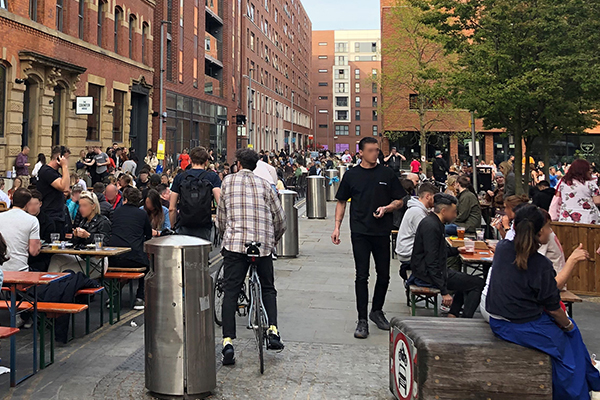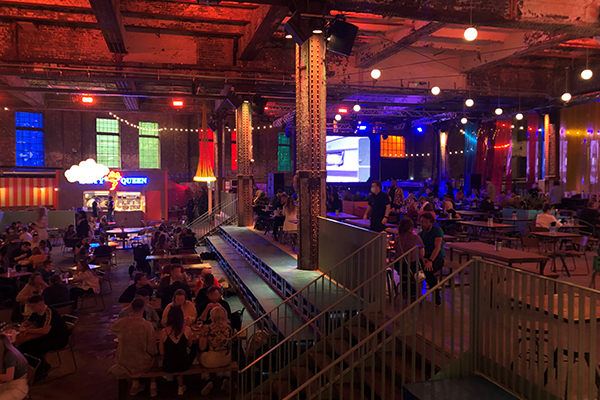Comment
Rip it up and start again: The opportunity to build back better starts with a wrecking ball
Neil Woodhouse, Director in our Design team believes that building back better in our town centres will likely start with a wrecking ball. The opportunity presented, he writes, is that where a suitable alternative use can’t be found we should embrace the chance to rebuild or repurpose and change our opinion of what we expect from our high streets.
Please excuse the overly dramatic title of this article, but I assure you – having been in the property industry for the last 12 years – I can vouch for it being proportionate to the topic.
I do not need to discuss the impact a global pandemic has had on our high streets, town and city centres. They are apparent to all. Shops, especially those deemed as non essential retail have been closed for the majority of last year. Many of our most iconic high street brands have met their demise, and those who survive lick their financial wounds as they reopen. Working from home (WFH) is the new buzz-word, leaving many offices and commercial districts empty. Stations, interchanges and roads once used to handling thousands of shoppers and commuters currently serve no more than a trickle of masked people.
The good news is that the image I paint above is only temporary. Slowly, we will come out of our pandemic induced hibernation and a “new normal” will start to become apparent. Unfortunately, the implications of lockdown will be long-lasting and are yet to be fully realised. What we do know – with some degree of confidence– is that there will be a lot of empty retail, leisure, office space and infrastructure which will take a long time to re-fill, if at all.
But out of these scenarios, there are real opportunities. Some of these are already starting to be realised, others are much more extreme and have the potential to be game-changers for our town and city centres.
Reclaiming the streets
Movement requires space, and one of the most inefficient forms of movement is the use of the private car. As people stopped commuting into our town centres, busy roads once filled with cars became empty valleys cutting across our centres, and car parks became impromptu plazas and squares. The pandemic has been a once in a lifetime opportunity for people to experience their high-streets without the car – or congestion – and it would appear we are starting to appreciate it.
Having been stuck in our homes for months and not allowed to socialise indoors for long periods , our appreciation of outdoor space has changed. How much space there is, how accessible it is and the quality of the space have become common considerations to many of us, especially those living in city centres without access to private gardens or spaces. With the concept of “social distancing” likely to remain in our psyche for the foreseeable future, and the belief that outdoor mixing is safer than indoor, demand for quality outdoor space is likely to continue.
Be it Birmingham, Bristol, Brighton or Belfast, we will have seen many popular town and city centre streets closed off to traffic and reclaimed by pedestrians and cyclists to enjoy both for recreation or relaxation. As bars and restaurants start to re-open, alfresco dining and seating terraces replace parking bays, and open air car parks become temporary event spaces and concert venues.
The consequence of this is that whilst we have been in a state of semi-lockdown and are still experiencing changeable British weather, many of our streets are more vibrant and active than ever. Streets are therefore safer and more accessible, especially in an evening, than they were before. But can such shifts be made permanent as we further progress out of lockdown, and will people be more willing to forfeit their cars for a less congested and high quality level of public space?

Rethinking how we use our town centres
For a long time, especially in the UK, our towns and city centres were a place to commute into for the purposes of shopping and work. Over recent decades, a shift has started to occur as patterns of behaviour evolved. The desire to be in walking distance of work and play led to the rise of urban living. The growth of online shopping resulted in a decline of retail floor space and the growth of leisure uses. These trends had become established long before the COVID-19 pandemic and were to continue regardless. However, lockdown has exacerbated what would otherwise have been an evolution, into a revolution with massive implications on our high streets.
Debenhams, John Lewis, Topshop, Dorothy Perkins, Oasis, Monsoon, DW Sports, Peacocks, Edinburgh Woollen Mill. Just a sample of the high street names that have either gone into administration or announced significant store closures as a consequence of COVID-19. The law of supply and demand is clear here. The BBC reported that so far, over 17,500 retail units will close across the UK and with the growing trend towards online shopping, this drop in demand is only due to continue.
Similar sentiments are mirrored with office space. As WFH has re-written expectations on where and how employees work, the demand for city centre office space is likely to drop as employees adopt more flexible working patterns instead of the Monday-Friday, 9 to 5 grind. The pressing question to landlords across the country is how to fill that space and with what?
Residential, leisure, recreation and community uses are the obvious answer, but with retail units often built for that specific use in specific locations, their suitability and adaptability for such new uses may be limited. Large format department store units are big, bulky and contain a lot of space to fill, whilst small ground floor retail units in historic buildings will offer little flexibility to adapt to non-retail uses.
“Outside of the box” and bespoke thinking will be required to resolve this, especially without a one-size fits all approach readily available. However, whilst the true implications and outcomes are yet to be realised, our high streets will need to be more diverse, more specific and likely more consolidated.

The game changer
Reclaiming our streets and rethinking how we use our town centres are obvious solutions to the immediate impact COVID-19 is having on our high streets. But whether it is streets, spaces or buildings, both of these approaches assume a suitable alternative use can be found. But what if this isn’t possible?
It would appear that local authorities and landlords are starting to contemplate such scenarios, and their responses represent an option which I doubt many would have even been considered a few years ago.
In the same way the Arndale Centre is associated with Manchester, the Bullring to Birmingham, or the St David’s Centre to Cardiff, a majority of our towns and cities across the country will have at least one major shopping centre, if not more. These have been a staple on high streets since the 1960s when the benefits of covered malls in the inclement British weather were truly realised. However, with fewer retailers available to fill retail units and their ability to adapt to other non-retail uses often limited, could this be the end of many such centres?
A look at towns and cities such as Nottingham and Stockton suggests this may be the case. In Nottingham, part of the Broadmarsh Shopping Centre has already been demolished with the rest due to be demolished soon. In Stockton, the Castlegate Centre whilst still open, is largely vacant with only a small number of tenants remaining. Demolition is therefore being muted. It isn’t their demolition however that marks a step change in approach, it is what will replace them.
Analysis by Radius Data Exchange reveals that of all the local authority owned shopping centres across the UK, nearly a fifth are being penciled in for demolition to be replaced with new public spaces or other community or residential uses. A new Riverside Park linking Stockton High Street with the River Tees is the centre piece of Stockton’s latest town centre masterplan, a feature to be facilitated via the demolition of the Castlegate Centre. In Nottingham, with no clear or viable proposals on the horizon for what is to replace the Broadmarsh Shopping Centre, proposals to turn the site into a new nature reserve and central park are gaining traction.
It has long been assumed that progress is a tangible process often measured by growth. A successful and healthy centre therefore is forever regenerating and growing. However, do these situations suggest such trends are no more? Have we reached the tipping point to suggest there is a limit to how much and how fast our high streets can grow, or that growth is a sign of success? How we measure and track the health and success of our centres is likely to change significantly, as well as our perceptions of the role and the services they provide.
There is no doubt that centres will continue to play a significant role in the future social, cultural and economic success of the places we live. The immediate and emerging impacts resulting from COVID-19 lockdowns are yet to be truly realised but are likely to be long-lasting and significant. However, our town and city centres are places which have always evolved, and whilst they are likely to be very different places as we enter our “new normal”, does this simply represent the next stage in the every changing horizon affecting them. The question however remains. Are we able to utilise the opportunities presented by this once in a lifetime event to help shape the future success of our centres moving forward?
Realising such opportunities will require strong vision for the future of our high streets and the courage to go beyond the norm, fighting against pre-conceived ideas of how our town centres should and shouldn’t be used. Now is the time to be bold, to support what has survived, repurpose what we value, but also rebuild and replace what has been lost in order to build back better.
For more information please contact Neil Woodhouse.
9 June 2021